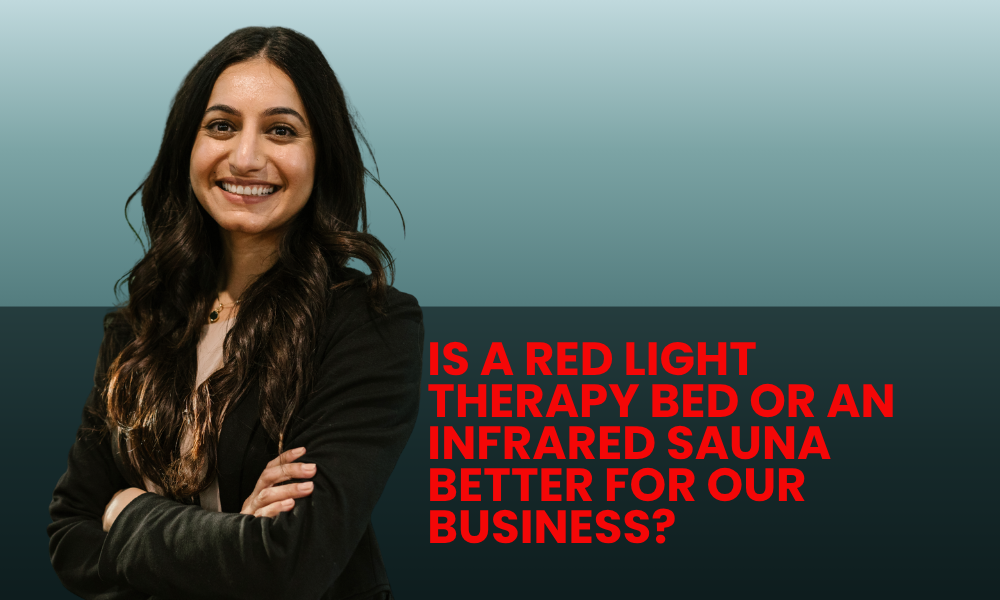Choosing Between a Red Light Therapy Bed and an Infrared Sauna in Your Clinic
When med spa or wellness clinic owners compare light-based therapies, one question comes up often:
Is a red light therapy bed or an infrared sauna better for our business?
They may look similar on the surface. Both use light, support recovery, and promise noninvasive results. But what’s underneath—biologically and strategically—is very different.
This guide breaks down the core differences between red light therapy beds and infrared saunas, and helps you determine which is best for your clinic’s goals, space, and clientele.
Understanding How Each Modality Works
Red Light Therapy Bed: Cellular Activation Without Heat
Red light therapy beds use red and near-infrared wavelengths (600–950nm) to trigger photobiomodulation. This process stimulates mitochondria—the “engine” inside your cells—to improve energy production, reduce oxidative stress, and accelerate healing.
This makes red light ideal for:
Inflammation
Chronic pain
Skin rejuvenation
Post-exercise recovery
Mood and energy regulation
These beds are full-body devices designed for short, frequent sessions with little to no perceived heat.
Infrared Sauna: Heat-Based Detox and Cardiovascular Effects
Infrared saunas, by contrast, use far-infrared heat (3000–10,000nm) to raise core body temperature. This triggers:
Sweating
Increased heart rate
Passive calorie burn
Detoxification via lymphatic stimulation
Sessions typically last 30–45 minutes and are primarily used for relaxation, stress relief, and cardiovascular support.
Key Comparison Points for Clinics
1. Treatment Time and Turnover
| Feature | Red Light Therapy Bed | Infrared Sauna |
|---|---|---|
| Session Duration | 8–15 minutes | 30–45 minutes |
| Number of Clients per Hour | 3–4 clients | 1–2 clients |
| Staffing Required | Minimal (self-serve) | Minimal |
Red light therapy allows for higher throughput, especially when using protocol memberships.
2. Primary Use Case
Red light beds: Best for targeted clinical outcomes—skin, inflammation, injury recovery, fatigue, immune support
Infrared saunas: Best for general wellness—relaxation, stress management, detoxification
3. Heat Sensitivity & Accessibility
Red light therapy is suitable for clients who can’t tolerate high heat (e.g., perimenopause, cardiovascular issues, sensitive skin).
Infrared saunas can be uncomfortable or contraindicated for clients with:
Low blood pressure
Heat-triggered migraines
Certain autoimmune conditions
How They Feel to the Client
Red Light Bed Experience:
Feels neutral to warm
No sweating or need to change clothes
Can lie down comfortably in normal attire
Infrared Sauna Experience:
Requires towel or minimal clothing
Induces sweat, elevated heart rate
May feel intense for some first-time users
Can These Devices Work Together?
Yes, and some clinics use both. However, they serve very different purposes.
If used in tandem:
Schedule red light therapy first to optimize light absorption
Follow with sauna for relaxation and metabolic support
Avoid stacking both in one session for heat-sensitive clients
Business Considerations Before Buying
Space: Red light beds fit in rooms as small as 9’ x 11’. Infrared saunas require more airflow and thermal buffer.
Energy Needs: Red light beds use 220V power. Infrared saunas often use 110V but generate more heat.
Pricing Model: Red light is ideal for protocol-based memberships. Saunas are more often sold as add-on wellness experiences.
If your goal is revenue from repeatable, clinical sessions, red light therapy wins. If your goal is relaxation-focused wellness with longer client stays, a sauna may work.
Seasonal Notes: Summer and Winter Use
Red light therapy beds are used year-round, often peaking during:
Allergy season: To support inflammation
Flu season: For immune resilience
Winter months: To counteract low energy and mood
Infrared saunas see seasonal drops in warm weather due to heat discomfort.
Red Light Therapy Delivers Stronger ROI
Clinics that switch from infrared-only models to red light often report:
Shorter sessions = more daily appointments
Higher retention via memberships
More predictable outcomes across skin, joint, and wellness clients
You can read more in our breakdown of the ROI of red light therapy.
Frequently Asked Questions
Will clients confuse red light therapy with sauna sessions?
At first, yes. That’s why clear signage and education matter. You can direct them to our red light therapy protocols page.
Is a red light bed harder to set up?
No. Most providers can setup your red light therapy room in under a week. All you need is 220V power and basic ventilation.
Can I upsell both?
Yes, but the client base and expectations will differ. Use sauna for relaxation. Use red light for recovery and results.
Choose the Technology That Fits Your Goals
If your business is built on measurable outcomes, fast appointment flow, and protocol-driven care, red light therapy offers the right mix of science and scalability.
Explore our red light therapy beds or book a setup call with our team. We’ll help you design a treatment room, pricing plan, and protocol system that works.


